Clash of the Titans - TT Tai Chi vs. CM Stacker 830
by Joshua Buss on February 23, 2006 12:05 AM EST- Posted in
- Cases/Cooling/PSUs
Cooler Master Stacker 830 (cont’d)
If the Tai Chi's approach to serious cooling is extreme conduction and convection, the new Stacker's approach is extreme venting and support for fans. In total, the 830 can hold 9 (yes, nine) 120mm fans. Four fit in the side panel (more on that later), three in the front attached to hard drive cages like the Tai Chi, one on top, and one in the rear. Now, we'll take a step back and examine the case from above at a further distance.
The top mounted vent on the 830 is passive by default (yet wasn’t in the system shipped to us), but a 120mm fan can be placed here if one desired. Something that pops out better in this picture than others is the handle configuration, which isn't as prominent as it is on the Tai Chi, but it is still just as useful and comfortable. Also in this shot, the holders for the four 120mm fans in the side are quite visible through the black mesh metal on the side.
Looking at the back of the case, we get an even better idea just how configurable this case is going to be. The first clue is that the side panels are very easy to remove – a clearly labeled black plastic tab on the top is all that keeps them from sliding back and detaching. Right next to these tabs are screws, which hold the plate that attaches to the PSU in place. While still slick, we prefer being able to slide a PSU in from the side of a case as it's slightly faster and easier, although modular power supplies are making this less of an issue. One of the three included 120mm fans is visible in this picture as well, exhausting the bulk of the warm air directly out the back.
With the left side panel off, much more of the Stacker 830 finally makes sense. The main feature, the 4x120mm fan array, is clear plastic and can swing out and be removed completely if desired. Only one fan is included in the panel, and it's identical to the fan in the back. It's also easier to notice that it's pretty much impossible to fit a power supply in from the side or underneath – it will have to fit through the back area.
Leaving the interesting left side for a bit, we should note that the right side is, for the most part, identical – but without the fan array, it looks pretty drab through the black grill and we'd caution users against exposing the right side of this case more so than the left considering how transparent the venting holes make the panel.
To keep the Stacker 830 tool-less, it uses removable plastic and steel locks, which slide pins into the respective 5¼” drives. They work well enough, but we prefer Thermaltake's more elegant thumbscrew solution, for aesthetic reasons. Screws could always be used here too, of course, but Cooler Master doesn't provide the same large thumbscrews Thermaltake does with the case.
One might notice that it could be a little harder to work inside the Stacker than most cases with the side fan cage in the way, but as noted above, it is a cinch to remove.
If the Tai Chi's approach to serious cooling is extreme conduction and convection, the new Stacker's approach is extreme venting and support for fans. In total, the 830 can hold 9 (yes, nine) 120mm fans. Four fit in the side panel (more on that later), three in the front attached to hard drive cages like the Tai Chi, one on top, and one in the rear. Now, we'll take a step back and examine the case from above at a further distance.
The top mounted vent on the 830 is passive by default (yet wasn’t in the system shipped to us), but a 120mm fan can be placed here if one desired. Something that pops out better in this picture than others is the handle configuration, which isn't as prominent as it is on the Tai Chi, but it is still just as useful and comfortable. Also in this shot, the holders for the four 120mm fans in the side are quite visible through the black mesh metal on the side.
Looking at the back of the case, we get an even better idea just how configurable this case is going to be. The first clue is that the side panels are very easy to remove – a clearly labeled black plastic tab on the top is all that keeps them from sliding back and detaching. Right next to these tabs are screws, which hold the plate that attaches to the PSU in place. While still slick, we prefer being able to slide a PSU in from the side of a case as it's slightly faster and easier, although modular power supplies are making this less of an issue. One of the three included 120mm fans is visible in this picture as well, exhausting the bulk of the warm air directly out the back.
With the left side panel off, much more of the Stacker 830 finally makes sense. The main feature, the 4x120mm fan array, is clear plastic and can swing out and be removed completely if desired. Only one fan is included in the panel, and it's identical to the fan in the back. It's also easier to notice that it's pretty much impossible to fit a power supply in from the side or underneath – it will have to fit through the back area.
Leaving the interesting left side for a bit, we should note that the right side is, for the most part, identical – but without the fan array, it looks pretty drab through the black grill and we'd caution users against exposing the right side of this case more so than the left considering how transparent the venting holes make the panel.
To keep the Stacker 830 tool-less, it uses removable plastic and steel locks, which slide pins into the respective 5¼” drives. They work well enough, but we prefer Thermaltake's more elegant thumbscrew solution, for aesthetic reasons. Screws could always be used here too, of course, but Cooler Master doesn't provide the same large thumbscrews Thermaltake does with the case.
One might notice that it could be a little harder to work inside the Stacker than most cases with the side fan cage in the way, but as noted above, it is a cinch to remove.


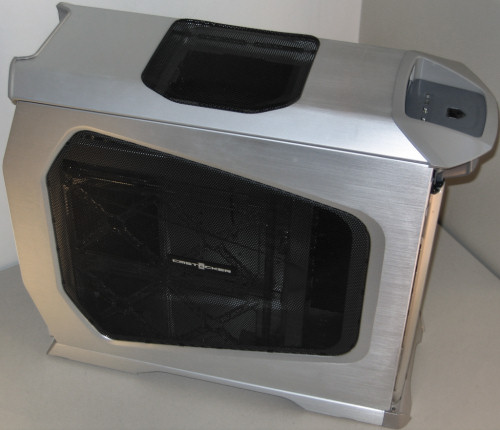
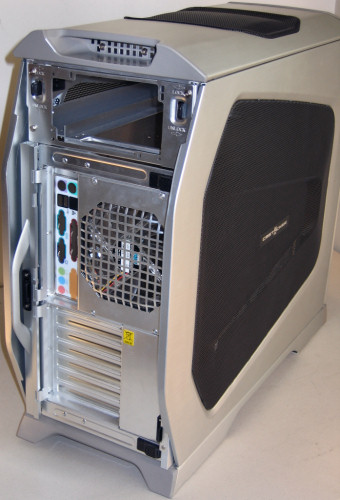
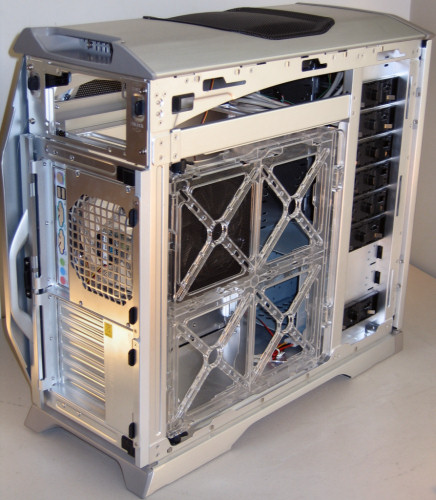
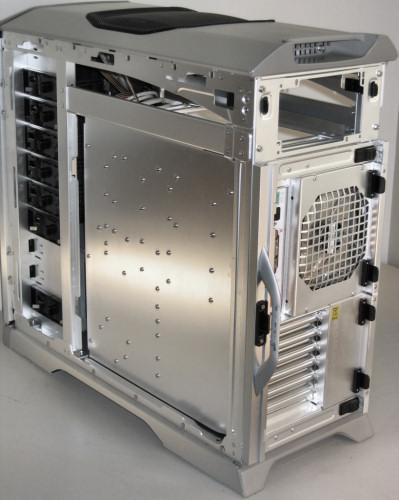
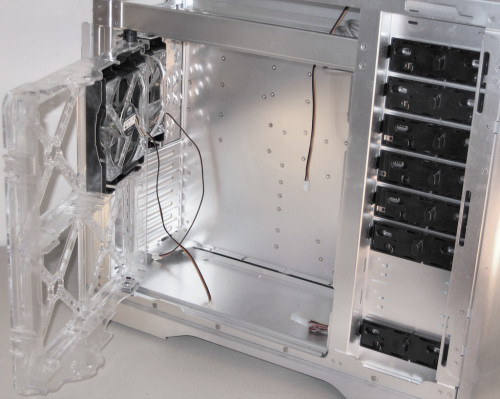








55 Comments
View All Comments
Tamale - Friday, February 24, 2006 - link
I made the most prominent mention of it right before the sound chart:"With the finding that the Tai Chi cools just as well as the Stacker 830 with half as many fans, one has to wonder if that means that the Thermaltake fans are making substantially more noise. To see if that's the case, we used our sound pressure level (SPL) meter and rated the system's noise subjectively on a scale from 1 to 10."
Even without taking the fans into consideration, the two cases' temperatures were very, very close. Look at the HTPC roundup to see how much they've different in the past.
JoshuaBuss - Friday, February 24, 2006 - link
1) It's ok for different people to have different definitions of 'high-end'. For me, a great case for a decent price is higher-end than a case that costs twice as much and doesn't offer as much.2) I mention the passive radiative design of the Tai Chi as a benefit, but perhaps didn't stress enough that the design is for the most part a waste unless one attaches additional cooling equipment to the sides so that conduction of heat to the fins would actually take place. What is true is that the case cools exceptionally well with only two fans. Is it the fins helping? While certainly I agree with you that they're not helping that much, I would still say that they're helping a little.
3) The cage itself lacks any active defense against vibrations unfortunately. Its design is of thinner material that has more bends to it, so inherantely it will aborb a little bit of the vibrations, but not much. We really preferred CM's cage in this regard, for this and the 4 drive capacity. That being said, seagate barracuda drives are still very, very quiet in the Tai Chi.
fsardis - Friday, February 24, 2006 - link
making the case out of alu does help dissipate heat from inside. the hot air does make the alu hotter and the fins increase the contact area with the ambient air.the only proper argument against the heat sink design is that although it has fins to dissipate heat outside, it doesnt have a large contact area inside so the hot air of the interior wont transfer heat to the alu as fast. then again all this applies only in cases of passive cooling. with active cooling the whole heatsink design is wasted since the hot air gets thrown out and fresh air comes in.
i am the owner of a stacker 830 and i am disapointed to say the least. there is not a single spot in the case to mount even a single water cooling rad. having read so many reviews on the net about how this case is good for water cooling, i seriously question the validity of other reviewers and not of the anandtech reviewer.
ATWindsor - Friday, February 24, 2006 - link
I doubt the difrence between fins and no fins when the side only has contact with air is within uncertanties int he measurments, i see it as little more than a gimmick. And aluminum in itself also have little improvment in heat (over steel).LoneWolf15 - Thursday, February 23, 2006 - link
can be a pain already, but the dual-doors like on the Tai Chi are worse than a single one, IMO. It can make it really hard to put a case under a desk, or in a small area, and I would get really tired of having to open two doors every time I wanted access to one of my drives (which is why I got an Antec P-160, which stealths the optical/floppy drives quite nicely without needing doors).I like the CoolerMaster's design. Still not a fan of a door on a case, but it seems cleaner than Thermaltake, whose cases have always come off as somewhat gimmicky to me.
Good review, guys.
JoshuaBuss - Thursday, February 23, 2006 - link
The dual-doors aren't really as bad as you'd might think, but yes, it will definitely be a problem unless you have a large open space to the left of the tower... that is of course only if you care about opening it at all.. hehkalaap - Thursday, February 23, 2006 - link
I don't think this case is made for small spaces.latino666 - Thursday, February 23, 2006 - link
Uhh I can't see the pictures anyone know reason why?Also I did use Firefox and IE
ATWindsor - Thursday, February 23, 2006 - link
For some odd reason i don't get up pictures on anand anymore if i disable referer-logging, could that be the case for you?TallCoolOne - Thursday, February 23, 2006 - link
I also cannot see the pics, and also tried both Firefox and IE.